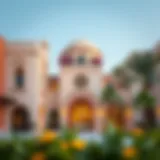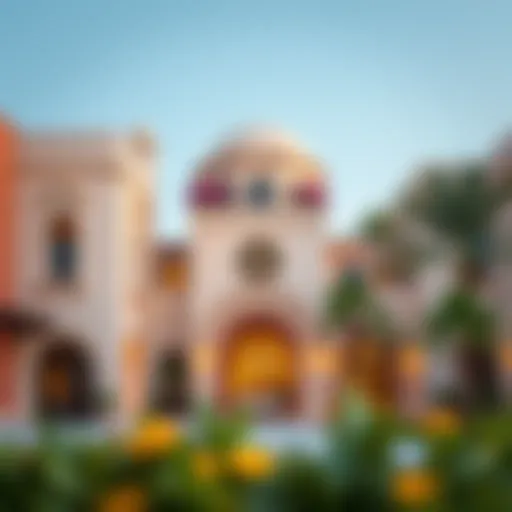Exploring the Architectural Marvel of Abdullah Al Shaiba Tower
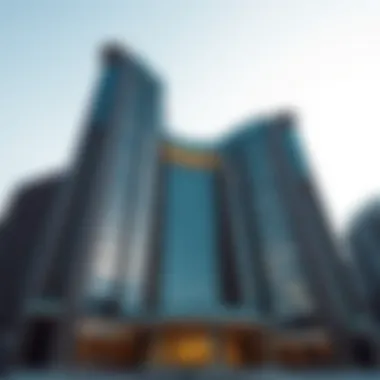

Intro
The Abdullah Al Shaiba Tower stands tall amidst Dubai's ever-evolving skyline, a monumental testament to innovative design and engineering prowess. This urban sentinel's significance extends beyond its architectural feats; it is intricately woven into the fabric of Dubai's real estate development and cultural identity. As we delve into the details of this impressive structure, we will explore not only its physical attributes but also the market trends and socio-economic dynamics at play in the shadow of its towering presence.
What makes the Abdullah Al Shaiba Tower particularly noteworthy is its role in reflecting the shifting tides of the real estate market in Dubai. As the city transforms into a global hub for commerce and tourism, this tower serves as a microcosm of the opportunities and challenges within the property sector. Through a comprehensive analysis, we aim to shed light on how this iconic building influences investor behavior, impacts local neighborhoods, and shapes Dubai's cultural landscape.
The journey ahead will not only highlight the engineering marvel that is the Abdullah Al Shaiba Tower but also contextualize its importance within a wider narrative of urban development. From its design intricacies to the economic ripples it creates, each aspect contributes to the understanding of how towers like this one resonate within Dubai and beyond.
Prolusion to Abdullah Al Shaiba Tower
The Abdullah Al Shaiba Tower marks a significant milestone in Dubai’s architectural narrative. Rising above the busy streets, it represents not only the skyline but also the story of modern urban development in the region. This landmark is more than just a building; it embodies the collective aspirations of a city striving to blend tradition with contemporary innovation. Located in a bustling commercial area, the tower serves as a focal point for both locals and visitors, symbolizing growth and prosperity.
Historical Context
Understanding the historical backdrop of the Abdullah Al Shaiba Tower reveals much about its meaning in the larger fabric of Dubai’s development. The early 2000s saw a seachange in urban planning in the UAE, with skyscrapers becoming a hallmark of progress. Evolving from a modest desert town into a metropolitan powerhouse, Dubai began to embrace ambitious projects. The foundation stones of the tower were laid against this wave of transformation, signaling commitment to artful architecture and advanced engineering. While individual stories of construction workers and architects might fade into the background, their collective labor crafted a landmark that now stands tall, as a testament to hard work and vision. The tower’s design reflects a fusion of cultures, which is emblematic of Dubai's diverse nature, incorporating influences from across the globe.
Location and Accessibility
Situated in the heart of Dubai, the Abdullah Al Shaiba Tower enjoys prime real estate that enhances its appeal. It's nestled near major thoroughfares, allowing easy access for both vehicular traffic and pedestrians. Commuters can rely on a robust public transport network, including the nearby metro stations and bus lines, ensuring that reaching the tower is as easy as pie.
The area surrounding the tower has seen a flurry of development, with restaurants, cafes, and shops sprouting up like mushrooms after the rain. This accessibility not only draws tourists but also supports businesses that flourish on the foot traffic generated by visitors to the tower. Furthermore, parking facilities are ample, easing concerns for those who prefer to travel by car. As the city grows, so does the importance of the tower’s strategic location, anchoring it firmly within Dubai’s urban fabric.
In sum, the Abdullah Al Shaiba Tower is a beacon of cultural significance, carefully intertwined with the historical evolution of Dubai and strategically positioned for maximum accessibility. Its towering presence invites a closer examination of its architectural marvels, societal impacts, and the engineering feats that brought it to life.
Architectural Significance
The Abdullah Al Shaiba Tower is not just a building but an emblem of modern architectural prowess. This towering structure contributes a unique perspective to Dubai's skyline, standing tall as a testament to innovation in design and functionality. While the tower is visually striking, its architectural significance goes beyond aesthetics; it is interwoven with principles that reflect both cultural and environmental considerations in urban planning.
Design Philosophy
The design of Abdullah Al Shaiba Tower encapsulates a blend of contemporary aesthetics infused with local tradition. This thoughtful approach aims to produce a structure that resonates with the rich heritage of Dubai while embracing the future of urban living. The architects meticulously considered the surrounding environment, emphasizing sustainability and energy efficiency throughout the building's design.
Key components of this design philosophy include:
- Integration with Nature: The tower's layout facilitates natural light penetration and ventilation. This reduces reliance on artificial lighting and cooling, showcasing a commitment to sustainable practices.
- Symbolic Elements: The design incorporates motifs that pay homage to Emirati culture, subtly weaving traditional patterns into the tower’s modern facade.
- Community Focus: The building encompasses communal spaces intended to foster collaboration and connectivity among its occupants.
In essence, the design philosophy intertwines both beauty and purpose, enabling the tower to soar above the ordinary.
Key Architectural Features
Among the notable features of Abdullah Al Shaiba Tower are those that reflect its architectural brilliance:
- Sleek Facade: The exterior is clad with high-performance glass, which not only enhances the visual appeal but also improves energy efficiency by minimizing heat gain.
- Multiple Terraces: Large terraces are strategically placed throughout the structure, offering panoramic views of the city. These spaces allow for outdoor relaxation and engagement, connecting occupants with the bustling life of Dubai below.
- Smart Building Technology: Advanced systems for climate control, lighting, and security are integrated into the tower’s infrastructure. This enhances the comfort of its users while promoting safety and efficiency.
- Towers of Greenery: Vertical gardens are featured on several levels, which serve both an aesthetic purpose and a functional role in air purification and noise reduction.
"The Abdullah Al Shaiba Tower showcases how modern architecture can harmonize with environmental sustainability and cultural richness, setting a new standard for urban development."
Engineering Marvels
The Abdullah Al Shaiba Tower exemplifies the pinnacle of modern engineering, pushing the boundaries of what is achievable in skyscraper design and construction. Its significance goes beyond mere aesthetic appeal; it highlights a myriad of advanced techniques and materials that truly makes it a beacon of innovation in an era where architectural challenges are increasingly complex. This section will provide an in-depth look at the construction techniques and innovative materials that underscore the tower's engineering prowess, thus solidifying its place in Dubai's architectural narrative.
Construction Techniques Used
At the core of the tower's robustness is the use of cutting-edge construction techniques. One standout aspect is the implementation of a top-down construction method, allowing work to progress simultaneously above and below ground. This technique significantly accelerates the overall construction timeline, enabling the project to stay ahead of schedule—considering the competitive nature of Dubai's real estate landscape.
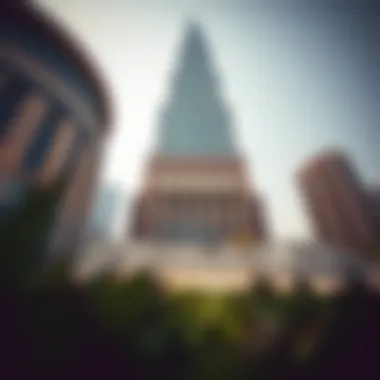

Moreover, the incorporation of advanced formwork systems was pivotal in creating the tower's unique structural design. These systems, often prefabricated, provide greater flexibility and efficiency by allowing for customized shapes while ensuring high-quality finishes.
Additionally, the employment of robotic automation in steel detailing and concrete placement has been a game changer. This technology not only maximizes precision but also vastly reduces human error, leading to a safer construction environment and enhanced structural integrity.
"Innovation in construction techniques allows us to redefine urban skylines, turning dreams into reality."
In tackling the harsh conditions synonymous with Dubai’s desert climate, engineers also employed comprehensive waterproofing and insulation strategies. The use of thermal barriers does not only protect the building from extreme temperatures but also adds energy efficiency—vital for sustaining operations in a city where energy demand often soars.
Innovative Materials
The materials utilized in the construction of Abdullah Al Shaiba Tower are just as impressive as the methods employed. High-performance concrete, which is resistant to the corrosive effects of the salty air typical of coastal environments, was an indispensable choice. This not only enhances durability but also contributes to the building's structural strength, enabling it to withstand the test of time.
Furthermore, the use of reinforced glass throughout the tower’s façade is noteworthy. Unlike traditional glazing, this innovative material offers heightened thermal performance and safety measures, a detail crucial in maintaining the tower’s sleek appearance while ensuring occupant security.
In addition, sustainable materials played a role in the tower’s design, aligning with Dubai’s long-term vision for sustainable urban development. For instance, the fiber-reinforced polymer used in select structural elements offers an excellent weight-to-strength ratio, promoting the overall energy efficiency of the building. This choice reflects a broader trend in architecture towards greener solutions that reduce environmental footprints while maintaining high performance.
Investors, agents, and analysts should take note of how these materials not only enhance the aesthetics of the tower but optimize its overall functionality, making the Abdullah Al Shaiba Tower not merely an architectural statement but a blueprint for the future of sustainable high-rise developments.
In summary, the construction techniques and innovative materials integrated into the Abdullah Al Shaiba Tower highlight the marvel of contemporary engineering that bridges artistry with functionality.
Impact on Real Estate Market
The Abdullah Al Shaiba Tower has not only reshaped the city’s skyline but has also made significant waves in the realm of real estate. The whims of the market respond to architectural marvels like this, with repercussions that touch both investors and residents alike. Its very presence is a beacon amid the ongoing transformation of Dubai’s urban landscape, illustrating the potent mix of aesthetic appeal and practical utility. This section endeavors to lay bare the far-reaching effects of the tower on the market dynamics and the associated implications.
Market Trends Post-Completion
The completion of the Abdullah Al Shaiba Tower marked a turning point for the Dubai real estate sector. As the tallest structure in its vicinity, it has attracted significant attention from various stakeholders, resulting in a notable shift in market trends. Here are a few key observations:
- Property Value Appreciation: Properties near the tower have seen considerable appreciation in value. The tower's reputation as a landmark creates a premium on surrounding real estate, making it an attractive zone for potential buyers.
- Increased Demand for High-End Developments: Investors are now keenly interested in high-rise developments that promise exclusivity and luxury. Abdullah Al Shaiba Tower has set a precedent, encouraging developers to pursue ambitious projects that echo its architectural flair.
- Rental Market Surge: The vicinity has experienced a surge in rental properties, as businesses and expatriates flock to the area. The allure of having a bird’s-eye view of the city and amenities suited for modern living have driven this trend.
As one expert puts it,
"The tower changes the perception of the locality, enhancing its appeal and economic viability. It’s more than a structure; it’s a statement."
Investment Potential
The investment landscape surrounding Abdullah Al Shaiba Tower is ripe with opportunity. Here's why:
- Strategic Location: Positioned centrally within Dubai, the tower offers easy access to major business districts, leisure zones, and transport hubs. This allure significantly boosts investment interest.
- Diverse Opportunities: The mixed-use concept adopted in the tower allows for various ventures, from commercial spaces to luxury residences. Investors have a unique opportunity to tap into multiple streams of income through diverse property types.
- Cultural Resonance: The tower’s design, which evokes local heritage while embracing modernity, resonates well with both local and international investors. Its appeal is not merely superficial; it signifies stability and growth within Dubai’s real estate framework.
Socio-Economic Effects
The socio-economic impact of the Abdullah Al Shaiba Tower cannot be understated. As a striking landmark in Dubai, this tower plays a crucial role not just in shaping the skyline but also in influencing the economic and social dynamics of the surrounding areas. The significance of these effects extends to various layers within the community and the broader landscape of urban development, making it an essential topic for investors, buyers, and urban analysts alike.
Community Development
The construction of the Abdullah Al Shaiba Tower has catalyzed substantial community development within its vicinity. In practical terms, this has led to the establishment of new public amenities, including parks, cultural centers, and local markets, virtually lifting the profile of the entire neighborhood. As businesses begin to thrive around the tower, a noticeable enhancement in the quality of life for residents emerges.
The tower symbolizes growth and aspiration, encouraging local governance to invest more confidently in infrastructure and public services. For instance, improved transportation links have been developed in response to the increased footfall, promoting seamless connectivity between residents and commercial hubs. Notably, strategic urban planning around the tower integrates residential and commercial spaces, fostering a vibrant, mixed-use community.
Furthermore, this environment attracts smaller enterprises and startups. Local entrepreneurs benefit from the foot traffic generated by visitors to the tower, leading to a symbiotic relationship that bolsters the local economy. As these small businesses flourish, they begin to create a regional identity that’s intricately linked to the tower itself, enhancing the cultural fabric of the area.
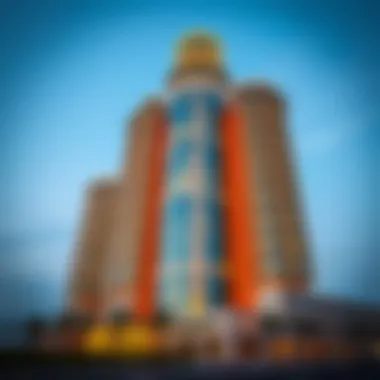

Job Creation
Job creation is another cornerstone of the socio-economic effects linked to the Abdullah Al Shaiba Tower. The very construction of the tower necessitated a massive workforce, spanning various sectors—from skilled labor involved in construction to professionals in management and oversight roles. This temporary boom in employment not only alleviated local unemployment rates during the tower's development phase but also set the groundwork for ongoing job opportunities post-construction.
Once operational, the tower fuels long-term employment opportunities in diverse fields, including hospitality, retail, and office management. Businesses attracted by the tower often need personnel ranging from service staff to high-level executives.
"The Abdullah Al Shaiba Tower does not just touch the skyline; it touches lives by creating jobs for thousands and invigorating the local economy."
The ripple effect of job creation extends beyond direct employment; it positively influences ancillary sectors as well. For instance, the demand for logistic services increases as more businesses set up, leading to the growth of transport and supply chain services in the area. In this way, the tower acts as a catalyst for a more bustling labor market.
Cultural Importance
Understanding the cultural significance of the Abdullah Al Shaiba Tower goes beyond mere aesthetics and height. This structure embodies the progression and ambitions reflected in Dubai's landscape, illustrating how architecture can symbolize prosperity, innovation, and cultural aspirations.
Symbol of Progress
The Abdullah Al Shaiba Tower is often heralded as a symbol of progress, not just for Dubai but for the entire region. It represents a break from the past and a stride towards a more developed future. Much like how the Burj Khalifa is seen as a beacon of what is possible in urban design, this tower also stands tall in its pursuit of excellence.
- Reflecting Modernity: The sleek lines and modern design elements of the tower present an image of a city that is continuously evolving. Its silhouette dominates the skyline and invites discussions about the shifting paradigms of architecture in relation to cultural development.
- Cultural Fusion: Within its walls, the tower houses various spaces meant to celebrate both local traditions and international influences, promoting a sense of inclusivity. Residents and visitors alike can appreciate exhibitions that reflect the emirate's rich cultural history.
"The Abdullah Al Shaiba Tower transforms the urban identity of Dubai, mirroring the dreams of its people."
This dynamic connection between the tower and its surroundings makes it a focus point for cultural dialogues, effectively serving as a monument to human ambition.
Touristic Attraction
Further enhancing its cultural importance, the Abdullah Al Shaiba Tower serves as a major touristic attraction. This development of iconic structures brings both local and international visitors, eager to witness the architectural prowess and cultural offerings present in Dubai.
- Architectural Tours: Guided tours of the tower provide insights into its design and construction, revealing the innovative techniques employed. Tourists can learn about the collaborative efforts between renowned architects and engineers, illustrating the city’s commitment to advanced design.
- Cultural Events: The tower often hosts cultural events and festivals that celebrate Emirati traditions and contemporary art. These gatherings provide an enriching experience for visitors, offering a glimpse into the cultural fabric of Dubai.
- Panoramic Views: Tourists flock to see the views from various observation decks. The vantage points allow them to appreciate Dubai’s rapid development from a height that begs reflection on the city’s journey.
The Abdullah Al Shaiba Tower is more than a piece of architecture; it's a cultural hub that marries modernity with tradition, simultaneously boosting Dubai's international stature and enriching its local cultural landscape. This intricate relationship between the tower and its cultural significance is essential not only to the city but also for investors interested in the real estate potential that such a landmark creates.
Challenges Faced During Construction
Building a skyscraper like the Abdullah Al Shaiba Tower isn't just about creative design or ambitious aesthetics. It involves navigating a minefield of challenges that influence timelines, budgets, and the very feasibility of construction. These challenges can range from environmental regulations to sheer logistical nightmares. Understanding these hurdles provides crucial insights for investors and real estate analysts, illustrating not only the complexity of such a project but also the resilience and adaptability required in modern construction.
Environmental Concerns
In today's world, construction cannot occur in a vacuum. The Abdullah Al Shaiba Tower had to address various environmental concerns that come with erecting a structure of its scale. These included:
- Ecological Impact Assessments: Conducting thorough evaluations of the site's flora and fauna ensured that the local ecosystem could sustain the construction activities without significant disruption.
- Sustainability Goals: As part of Dubai's commitment to sustainable development, the tower needed to incorporate eco-friendly materials and energy-efficient systems. This often meant balancing innovative design with practicality and cost.
- Waste Management: With a project of this magnitude, waste management becomes critical. Innovative waste reduction strategies had to be implemented, ensuring that as much material as possible was reused or recycled.
Such points illustrate that, while the tower represents architectural progress, it also embodies a commitment to environmental stewardship. Investors who prioritize sustainability may find the tower to be an attractive project in their portfolio.
Logistical Hurdles
Logistics is often the unsung hero in large-scale construction, and the Abbott Al Shaiba Tower was no exception. Key logistical challenges included:
- Supply Chain Management: Materials for construction had to be timely and readily available. This required meticulous planning and coordination with various suppliers, often involving a multitude of international shipments. The distance wasn't just geographical; it was also about navigating different regulations and certifications.
- Workforce Coordination: Managing a sizeable workforce from diverse backgrounds and skill sets was itself a task. Effective communication and training were paramount in ensuring safety and efficiency on-site.
- Urban Constraints: Located in a bustling area of Dubai, the construction site found itself battling space constraints. Street closures and traffic management became regular considerations, complicating both material deliveries and worker commutes.
These logistical hurdles are not something that most casual observers consider, yet they are the backbone of successful construction projects, illustrating the need for diligence and foresight in planning.
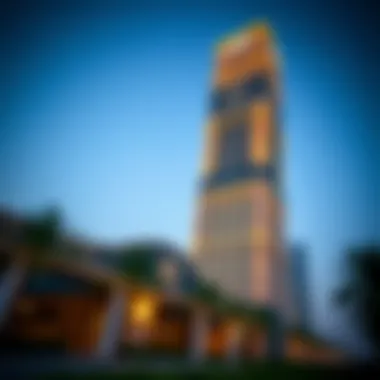

"There are no small problems in construction. The details often hold the key to success."
The Future of Abdullah Al Shaiba Tower
The outlook for the Abdullah Al Shaiba Tower represents not only a reflection of architectural ambition but also an embodiment of sustainability and strategic planning within a rapidly transforming urban landscape. As global dynamics shift and environmental concerns take center stage, the future of this iconic structure becomes pivotal in projecting the essence of Dubai's identity. Its continued evolution could potentially redefine the standards for skyscrapers, making this discussion paramount to stakeholders ranging from investors to city planners.
Sustainability Initiatives
Given the pressing challenges posed by climate change and urban congestion, the Tower is positioned to lead by example through its commitment to sustainability. Several initiatives are already in place or planned to enhance the tower’s environmental footprint:
- Energy Efficiency: Incorporating advanced energy-efficient systems, the tower aims to reduce its reliance on traditional power sources. For instance, the installation of solar panels on the roof can significantly cut down on electricity usage while promoting renewable energy use.
- Water Conservation Techniques: Utilizing smart plumbing systems helps in minimizing water waste. Additionally, rainwater harvesting encourages efficient resource use, aligning with Dubai's goals for sustainable living.
- Green Building Certifications: The venture for obtaining recognized certifications like LEED (Leadership in Energy and Environmental Design) positions the tower within a network of commendable global architecture. These certifications not only validate the building’s environmental commitments but also attract eco-conscious investors.
This strategic focus on sustainability not only enhances operational efficiencies but also positively shapes public perception, fostering trust and credibility amongst potential tenants and investors.
Long-Term Vision for Development
The overarching concept for the future of the Abdullah Al Shaiba Tower centers around a long-term vision that embraces adaptability and growth. Key considerations include:
- Integration with Urban Infrastructure: The tower will serve as a vital node within Dubai's widespread transportation network, enhancing accessibility through strategic connections with metro stations and bus routes. This interconnectedness fosters bustling economic activity in the area and increases the Tower's appeal.
- Dynamic Usage of Space: The vision includes a blend of commercial, residential, and recreational areas, ensuring that the tower is not merely a standalone icon but a vibrant community hub. Such versatility will draw a diverse array of occupants, enriching the surrounding neighborhood.
- Cultural Programming: Plans for cultural events and public spaces around the Tower encourage community engagement and reinforce the structure's importance as a cultural landmark. Initiatives may include art exhibitions or local markets, enhancing its role in shaping the city's cultural landscape.
"The Abdullah Al Shaiba Tower is not just about height; it symbolizes a modern way of living in harmony with our environment while ensuring economic vigor."
Comparative Analysis with Other Skyscrapers
Understanding the place of Abdullah Al Shaiba Tower within the broader context of skyscraper architecture is vital for discerning its significance in the realm of modern urban development. This analysis allows investors and stakeholders to appreciate the nuances of design and functionality in comparison to other notable towers. It reveals how this structure not only meets but often exceeds expectations through innovative engineering and thoughtful design.
Regional Comparisons
When analyzing the Abdullah Al Shaiba Tower alongside regional counterparts, it's crucial to consider the architectural styles and cultural significance that inform each building's design. For instance, towers such as the Burj Khalifa in Dubai or the Kingdom Center in Riyadh present compelling points of reference.
- Height & Design: While the Burj Khalifa holds the title of tallest, Abdullah Al Shaiba introduces a fresh take on style, with its emphasis on sleek lines and eco-friendly materials. This does not merely compete in height but stands as a statement of innovation.
- Cultural Context: Each skyscraper tells a story—not just about height, but about the identity of the city it inhabits. The Abdullah Al Shaiba Tower, with its unique facade, captures Dubai’s rapid growth while paying homage to traditional Arabic architectural elements, setting it apart from more modernist approaches of other regional towers.
- Functional Spaces: The mixed-use design of the Abdullah Al Shaiba distinguishes it. Unlike others that tend to focus solely on commercial or residential purposes, this tower integrates societal needs like community spaces, aligning it closer to the needs of modern urban dwellers.
These comparisons reveal a landscape of competition and inspiration that drives architectural innovations in the region, emphasizing the need for sustainability, cultural representation, and community involvement.
Global Perspectives
Looking at the rise of skyscrapers globally, Abdullah Al Shaiba finds itself in a tantalizing position among global giants like One World Trade Center in New York and the Shanghai Tower in China. Both serve as great examples of how urban icons symbolize their cities.
- Global Trends: It reflects global shifts towards sustainability and engineering advancements. For example, while the Shanghai Tower incorporates a double-skin facade for energy efficiency, Abdullah Al Shaiba also embraces eco-friendly technology, positioning itself favorably in discussions of responsible architecture.
- Market Influence: On the global stage, the performance of a skyscraper often shapes local economies and influences real estate values. Abdullah Al Shaiba’s successful integration into Dubai’s skyline potentially enhances the economic allure of the surrounding area, similar to the economic uplift witnessed around London’s Shard.
- Design Inspiration: The fascination with mixing technological innovation with local aesthetics has garnered worldwide attention. As cities grapple with overpopulation and environment impacts, the approach of Abdullah Al Shaiba could inspire future projects, encouraging a blend of beauty and functionality that speaks to city dwellers everywhere.
"The real value of skyscrapers goes beyond their height; it's about how they resonate with the societies they inhabit, embodying their aspirations and challenges."
Finale
In summing up the myriad facets of Abdullah Al Shaiba Tower, it’s essential to emphasize the tower's monumental role in not just Dubai's skyline but also its socio-economic landscape. The finished structure embodies more than just innovative design; it serves as a beacon of progress, resilience, and strategic vision amidst the city’s rapid urbanization.
Summary of Findings
The exploration revealed a wealth of insights, including:
- Architectural Ingenuity: The tower’s design reflects a unique blend of modern aesthetics and cultural heritage, symbolizing the Emirate's commitment to embracing contemporary architectural trends while honoring its roots.
- Engineering Triumphs: Overcoming various challenges during construction underscored the robustness of engineering practices employed, from material selection to innovative construction techniques that have set new benchmarks for future projects.
- Economic Influence: The tower has catalyzed rejuvenation in the real estate market, leading to enhanced investment opportunities and significantly impacting surrounding areas. Investors and stakeholders are now eyeing similar endeavors with increased ambition, given the tower’s success.
- Social Benefits: The tower stands not just as a commercial asset but also as a hub for community engagement and growth, fostering job creation and stimulating local economy through ancillary services and tourism.
Final Thoughts
"Every great tower begins with a single brick; Abdullah Al Shaiba Tower is a testament to what careful planning and bold ambition can achieve."
As we wrap up our exploration, looking ahead, it is clear that the implications of the Abdullah Al Shaiba Tower’s success set the stage for future skyscrapers and urban development strategies. Clearly, this iconic structure is both a harbinger of progress and a catalyst for momentum in a rapidly shifting landscape.






